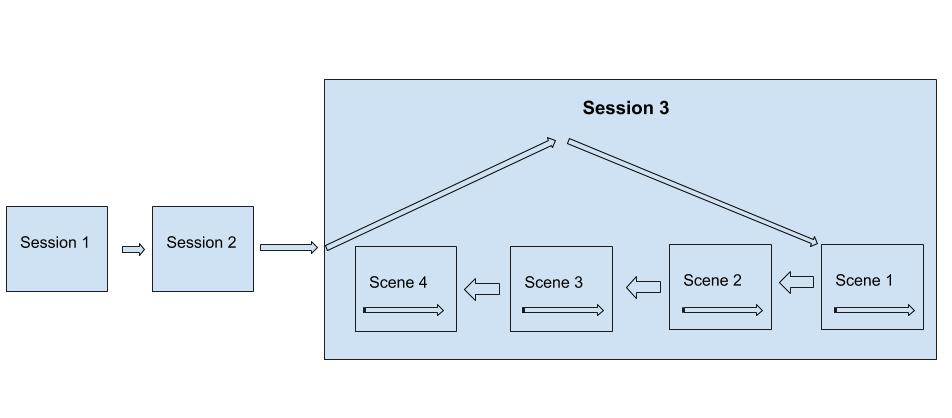 I’ve been running a sequence of four game sessions working with James V. West’s The Pool.
I’ve been running a sequence of four game sessions working with James V. West’s The Pool.
The mechanics of The Pool are lean and streamlined: Players start by creating a 50-word story introducing their characters. Traits and attributes are derived from those stories, and a players can assign points to those traits according to a simple formula. They leave some points (usually 3-5) for their “pool” which they can then use to boost the number of dice they roll in the case of a challenge or conflict. The number of dice involved in a roll is the sum of:
- The points of the trait involved
- 0-3 discretionary dice awarded by the GM
- Gambled dice from the pool
- If a player succeeds in their roll, they can choose to deliver a Monologue of Victory (which gives them the power of controlling the narrative for a short period of time) or to add another die to their pool.
For our first session, we used the rules as written by James West, and on subsequent weeks we have moved to variants. To get the players in the same head space, I sent them some pictures with the statement, “These are some of the inhabitants you see around the village in which you live.” One player used the term “rustic fantasy” to describe the kind of setting and atmosphere that developed from that seed.
I am focussing this Actual Play report on our most recent session (Session 3), which incorporated some rules from a variant of The Pool called The Snowball (by Alexander Cherry). You can see the video below.
The most significant changes to core rules involve:
- The LOSS of gambled pool dice on a SUCCESSS (in the original rules, you lose those gambled dice when you fail a roll.
- The addition of a Monologue of Defeat (in addition to the core rule’s Monologue of Victory).
- The playing of the game in reverse chronological order.
[Note: We are not incorporating all the rules of The Snowball, in part because this is part of an ongoing campaign whose previous sessions were run the proper rules of The Pool and the Anti-Pool Variant.]
I hope to produce a summary of the entire 4-session series when we have completed it, but I wanted to make some specific observations about this Snowball session because the reversed chronological order touches upon some other issues recently raised at Adept Play. Those issues include those of “knowing the future,” the requirement to roleplay in terms of a necessary goal or terminus, and improvisation within increasingly rigid structure.
I’m including a diagram to help with establishing how the session was organized. Sessions 1 and 2 were already “in the can,” and they established a known and unalterable backstory for the players (who had participated in those sessions). For the first scene of Session 3, we lept to the future.

As the GM, my procedure was to give the players a setting and some detail. I then went around the table and each player could briefly establish where their character was and what their character was doing and/or feeling as the scene opened. From there we roleplayed to a point where we were satisfied that the scene had come to a sense of closure or conclusion.
I then transported us back to Scene 2 using the same scene framing technique: The GM provided a setting and some interesting details, and the players inserted their characters in the scene. We then played out the scene with a major objective in mind: Namely, we needed to end at a narrative point close to where Scene 1 began.
Play proceeded in this manner until we ended with a scene that was in close narrative proximity to where we had ended in Session 2.
A few things to note:
- The starting point of Scene 1 was constrained by the basic “facts” established by the first two sessions, but otherwise was open in terms of content. Likewise, the end point of Scene 1 was determined by play and not planned. Scene 1, in other words, was very similar to the way we had been playing in previous sessions with the exception that there was a notable time gap that had elapsed. As a result, Scene 1 begins with a disorienting in medias res moment as the players try to figure out what has been happening. But this “figuring out” follows the “pump” model (State 2) of play as described by Ron: That is, it proceeds “from a pressurized position into a unique and unplanned circumstance.”
- The later scenes, by contrast were much more constrained. We had some freedom with the starting point of the second and following scenes, but the end points were largely predetermined (by virtue of the fact that they had to fit in with the starting point of the scene we had previously played). That said, we found that we could modulate the difficulty of the play by considering the details of one scene and then deliberately framing the “next” scene with some of those elements in mind. To illustrate:
- Scene 1 was set in the middle of an ancient stone circle. A plinth in the center was covered with the shards of a broken blood-red gem, and a hot war hammer lay on the ground. During the scene, an earth golem was discovered to have been involved in the act of destruction, and one of the characters (Auntie Pine) notifies the company that she is leaving her role as the firekeeper of the village.
- It eased the way in Scene 2 to frame things such that some of those key elements from Scene 1 were already in play or explained.
- The final scene of the session was the most heavily constrained: We had to start with the end-point of Session 2 and end with the starting point of the last scene we had played. (Hopefully the diagram helps to make all this clear!)
- WITHIN the scenes, events run in normal chronological order; it is the initial scene framing which involves the move to the past.
This way of play required us to move from the pump model to a funnel model of play, and this is one reason why the players were challenged. Note that we could have taken a funnel approach from the start our our very first session, but my play group was happy to begin with some basic aspects of setting and then work out a story in the course of play without any predetermined end point. So Sessions 1 and 2 along with Scene 1 of Session 3 all followed with this pump approach. But with the retrograde chronology of The Snowball in place, Scene 2 and the following scenes have to abide by the funnel.
This made for a curious experience, especially since the trajectory of our story had not previously been decided ahead of time. Now, we were playing a series of scenes where a specific goal was in mind. Unlike a usual funnel, however, this goal was now a narrative necessity: Had we decided to pursue a different goal, our story would have fallen apart, and we would have been left with two scenes that no longer meshed with each other. Normally, the funnel is more optional.
This style of play also required some special focus and deliberation on our part. You will particularly notice this towards the end of the recording when one of the players who was battling fatigue realized that it was on him to do something with his character to preserve the narrative continuity, but memory lapses were making this task virtually impossible. I had to provide some prompting for his light bulb to go off.
I don’t think our play required any extensive fudging of the rules as we set them up at the start of the session, though with a more merciless or deadly rules system, that would change. For example, if you were following a reversed chronology and you knew that a character was alive in one scene, then what if the mechanics of your game dictated that the character died in the scene that immediately preceded that one in time? That would face you with a gordian knot, with the easiest solution being to massage or alter the results.
A few general observations about our experience playing with The Pool and some variants:
- Using magic as a trait in a fantasy setting provides so much power within this system, and there are times when I wish that we could limit it because it can so effectively overshadow some other attributes which are more unique and curious. Traits like old age, storytelling, and cooking are interesting to put into play, but once the magic gets rolling, those traits are getting forced to the wings.
- The Monologue of Defeat and consequences of failed rolls motivate interesting narrative twists, but when they are the result of GM-forced rolls involving perception or knowledge, they get more tricky. To explain: Imagine that the GM asks a character to roll because they want to see if a character realizes something about an event taking place. If the character fails the roll, then it can be hard to think of some narratively consequential impact (i.e. something more than simply that the character remains ignorant of something).
Questions or comments about The Pool, The Snowball, or issues raised by our play are welcome.

2 responses to “The Pool and the Snowball: Forward to the Past”
So much to consider
You probably know from this site that your program is pretty much a dream of mine, to examine many aspects of play through the variants of The Pool. For people who haven't seen my presentation about the game, it's Discuss: The Lesson of the Pool, especially the attached PowerPoint.
Anyway, John has a current post about playing Lamentations of the Flame Princess in "play in the past" mode, so I'm trading thoughts between the two and not sure what point is best suited for which. To display that confusion, I'm going to pirate something I said at his post:
The relevance here (I hope) is to consider three grain sizes for "backwards" play.
The biggest is what he's doing and what I've presented and played in Sorcerer & Sword: whole adventures, with multiple sessions, internally played linearly, but placed before or after the adventures that have already been played. Vincent's In a Wicked Age … also allows for doing this.
Then the middle size is what you're doing, with scenes during a session. This is a lot like cinematic flashbacks, which can be done to its extreme in a film like Memento, or mixed up a bit with maybe one key "past" scene, or done almost in parallel where we "see" the past events in pieces that arrive juxtaposed with present events arriving too. For some reason I seem to be stuck 90s film head-mode today, so I'll go ahead and mention Pulp Fiction and Dead Again too, both of which use out-of-sequence presentation very logically for purposes of understanding the story. (I'm hesitant to mention PF because it always prompts mindless meme fests and unconsidered repeat-statements from pop media; to anyone reading this, please spare me all of those, thanks.)
Finally, the smallest grain is actions, a bit like I'm talking about for Bill & Ted, or less obviously, in role-playing, saying something like "Hey, wouldn't I have called her before we got here," and someone else confirming "that would make sense" so now it's OK for this person to arrive, in response to the call that we just invented, but don't feel as if we just invented.
I am enjoying exploring this
I am enjoying exploring this experiment vicariously. Thank you for sharing~